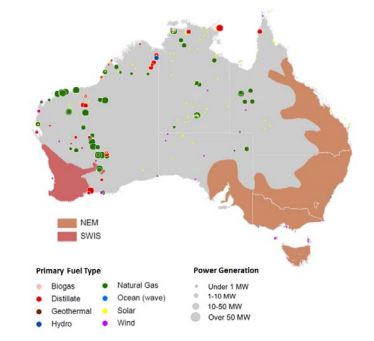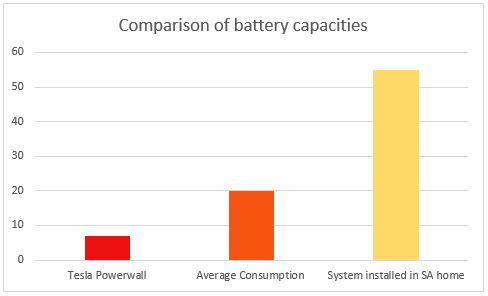Going off-grid, goes West
Farmers in Western Australia’s West River in the Ravensthorpe shire (around 500 km south east of Perth) are participating in a trial which will take six households off-grid, in order to assess this approach for reliability for those living at the edge of grid.[i]
The bill for a solar and battery system with backup diesel capable of providing sufficient power during the trial is estimated to total $150,000 per household.[ii] With even a basic solar and battery set up coming in at around $10,000 (solar choice 1.5kW solar panel $2,311, LG Chem 6.4kW battery $7,615[iii]) it’s what makes going off the grid so expensive and the question, why are some remote residents still prepared to do so?
The costs of solar photovoltaic (PV) and storage have decreased dramatically, for example, in the five years, 2010-2015 the price of solar PV dropped by 80 per cent.[iv] Additionally, the price of batteries has fallen on average by 14 per cent every year between 2007 and 2014 and prices are predicted to halve over the next five years.[v] This decrease in price has helped encourage a surge in the uptake of solar PV across Australia, with some states now having installation rates as high as 30 per cent of households. Queensland and South Australia are at the forefront of the solar PV uptake.[vi] With this rise in PV generation and the reduced cost of battery storage some people are considering the option of going off-grid.
While costs continue to fall, the installation costs for a system which can supply all of your electricity needs with no grid back up still does not come cheap, with set up costs totaling over $100,000[vii]. However, the cost-benefit case can change when considering edge of grid areas. Ros and Bernie Giles have lived in West River, around 500kms south of Perth, since the 1980s. They initially supplied their energy needs through [diesel] generators, but eventually paid for grid connection in the late 80s. However, due to the challenges of maintaining grid infrastructure at edge of grid locations, they are now participating in the WA trial and supply their own energy needs.
The problems of grid reliability, efficiency and cost of maintaining the more remote parts of the grid has resulted in the WA Government running a trial involving Synergy, Western Power and Horizon. The trial will take six properties in the Ravensthorpe, Lake King and Ongerup area off-grid via the installation of stand-alone power systems made up of solar panels and batteries, as well as a backup diesel generator (the properties will also remain connected to the Western Power grid during the 12 month trial, while not using it to source their power). The -standalone solar and storage system for the Giles family will cost $150,000, with the WA government fronting the cost.[viii]
Where grid infrastructure has to span large areas, the addition of generation close to demand can improve efficiency from transmission losses, as well as reliability[ix]. The grid in this portion of WA stretches over 250,000 km2 but only provides power to a very small proportion of the population (the Ravensthorpe shire has a population of just over 2,100). This can pose a serious challenge with grid maintenance and any grid extension or upgrades coming with a large price tag. A report from Oakley Greenwood into edge of grid situations found that it may be more economically viable to move groups of customers off-grid than to maintain the existing grid connection.[x] This will depend on the particular circumstance but the falling costs of distributed energy technologies is likely to increase the possibility for more off-grid residents in the future. Figure 1 shows the current grid distribution of the National Electricity Market (NEM) and the South Western Interconnected System (SWIS) and locations with off-grid generation.
Figure 1: Existing grid network and off-grid generation [xi]

As shown in Figure 1, there are extensive areas not covered by the grid, or that exist at the edge of the grid. According to estimates from the Oakley Greenwood, there are approximately 100,000km of grid which could be classified as edge of grid, although currently this lacks exact definition:[xii]
‘A similarly conservative assessment of the number of customers is that there are 25,000 customers supplied at the edge of grids. There is no formal definition of edge of grid and thus no standard means to assess either the length of line or the number of customers affected. If edge of grid is determined by whether it is economic to consider a distributed generation solution then the boundary of edge of grid will move progressively deeper into the grid if distributed generation and storage costs fall relative to the cost of grid-supplied electricity. Accordingly, the length of line and number of customers who may benefit from a distributed generation option should be expected to rise and exceed the conservative assumption considered here.’[xiii]
This represents consumers like the West River farmers, who live on the edge of the SWIS.
The financial and logistical challenges of grid maintenance for small numbers of customers was demonstrated after a bushfire in Esperance, in southern WA. The 2015 fire destroyed transmission lines connecting a handful of farmers to the grid. Faced with rebuilding 14km of powerlines to service only two customers, Horizon Power and Synergy opted to provide the farmers with a standalone renewable energy system rather than rebuild the grid.[xiv] For the Esperance farmers, solar panels, batteries and a backup diesel generator were provided by the utility with customers only paying normal electricity rates. Esperance was the first project of this type in WA and supported five standalone systems[xv]. The trial is helping in the assessment of the potential for utilities to supply standalone energy systems for other remote customers to be a more economically viable infrastructure investment than traditional grid connection.
These off-grid experiences are not exclusive to remote Western Australian residents. One family who built their home near McLaren Vale outside of Adelaide also opted to install a standalone renewable system as opposed to connecting to the grid. While the grid was only 300m from the property, the family was quoted more than $100,000 for a connection. When other additions were added to the bill, the total reached nearly $200,000 for the home to be connected[xvi]. Faced with this cost, other options became more attractive. The home was installed with a 20kW solar system combined with 55kWh of battery storage, coming in at a (relatively) cheap $120,000. [xvii] Despite this expensive and large system, power can only be supplied for three days without solar input. As a result, a diesel generator was still required for times when the sun does not shine for multiple consecutive days.
The difference between the McLaren Vale example and the WA examples above is that the Mclaren Vale family were not connected to the grid so they faced either the grid connection cost or the standalone cost, so were well placed to choose the cheaper option. For customers at the edge of an existing grid, they typically pay the same tariffs as urban customers and so don’t themselves face the cost of maintenance or upgrade. Instead these are incurred by the local network service provider (NSP), who then smears the costs across all their customer base. This means the NSP is the one facing the cost tradeoff and who may be motivated to offer a standalone solution. This is where the regulatory questions start to arise. Can the NSP make the decision to provide off-grid supply if service levels are maintained and tariffs remain the same, or is it always the customer’s decision (even though they are not facing the true cost-trade-off). Should there be competition to provide power in such circumstances or does supply always remain with the regulated monopoly NSP?
While you can purchase a battery for less than $10,000[xviii], models such as the Tesla Powerwall only have 6.4kWh usable power storage. When one considers that the average four-person home in West River consumes 20kWh per day[xix], this system falls short of supplying a household’s energy needs. To demonstrate the inadequacy of a storage system of this size to take your house off the grid, this size battery would provide just over seven hours of supply when the sun isn’t shining, either at night or on cloudy days. This is assuming that energy use is constant throughout the day and the year, which is not usually the case. Demand usually peaks on a daily basis in the evenings and extreme heat and cold also create peaks in demand that differ from average consumption. The implications of peak demand mean that even when a large system, such as the one installed for the South Australian family is installed, behavior around energy use will almost certainly have to change. This means changes such as not running the air conditioner and the washing machine at the same time. Or putting on the dishwasher only when the sun is shining. While the necessary behavior change will depend on the system in question, energy usage must be more seriously considered and is limited by the constraints of the system installed. This may mean a marked change in lifestyle for those accustomed to the responsiveness of the grid where all it takes is a flick of the switch to power all your desired appliances.
Behaviour change is being investigated as an alternative to grid upgrades in the remote WA community of Port Hedland. Horizon Power, the regional power supplier in WA, is trialing a scheme where participants will be paid to limit their hourly consumption during peak periods. In this trial, participants will be paid incentives to reduce energy consumption between 1pm-8pm, peak consumption times in the area. This is being investigated as an alternative to adding capacity to the microgrid, which would represent a large infrastructure investment. This project demonstrates the importance of behavior change when supplying energy needs on a small scale, either at community or household level. It also illustrates another aspect of the regulatory conundrum. Port Hedland customers already benefit from subsidised electricity through the WA government’s Tariff Equalization policy. Again, it’s because they don’t face the true marginal cost of their electricity supply, that Horizon has to use incentives, which means other customers are subsidizing them even more, although of course the scheme is designed to save Horizon money overall.
Figure 2 graphically demonstrates the capacity (in MWh) of a Tesla Powerwall, the average consumption of a four-person home in West River WA[xx] and the capacity installed in an Adelaide resident’s home who chose to go off-grid using only solar and battery storage.[xxi]
Figure 2 Comparison of capacity of Tesla Powerwall[xxii], average consumption for a four person house in West River[xxiii] and the capacity installed in an Adelaide resident’s home[xxiv]

While the cost to residential households of going off-grid may be prohibitive, this may not be the case for businesses at edge of grid locations. For businesses, the cost of lost power supply due to grid maintenance or extreme events can present very direct financial losses. But as noted above, to be confident of greater reliability, businesses are likely to need diesel in addition to solar and batteries. Whether businesses or households, users going off-grid with such a package will need to take on board new considerations, including arranging their own maintenance, fuel supply for the generator and the potential for noise or emissions to be an irritant.
Conclusion
The reduced cost of battery storage makes it a potential option for users to get the most out of their solar PV. However, solar and storage options still remain very expensive for those who wish to be independent of the grid. It turns out that despite the ramp-up in electricity bills over the last decade, grid electricity is still good value. Grid independence can become a competitive financial option when faced with high costs for infrastructure upgrades for edge of grid residents. In addition, problems of grid reliability and vulnerability to extreme events, such as those experienced by WA farmers, may also add incentive to go off-grid. However, with the current prices of solar and batteries, it still does not make economic sense to go off the grid, except for those in remote locations who do not have a current grid connection or are on the edge of grid and face reliability challenges due to the difficulties in maintaining large amounts of infrastructure for small groups of customers.
[i] https://www.mediastatements.wa.gov.au/Pages/Barnett/2016/07/Regional-energy-trial-helps-residents-go-it-alone.aspx
[ii] http://www.abc.net.au/news/2016-08-06/solar-could-be-game-changer-for-rural-communities-on-grid-edge/7681398
[iii] http://www.rpc.com.au/catalog/lg-chem-lithium-ion-battery-6400wh-48v-p-4164.html
[iv] Agnew, S. & Dargusch, P. 2015. Effect of residential solar and storage on centralized electricity supplysystems. Nature Climate Change, 5, 315-318.\
[v] Climate Council, 2014. Powerful Potential: Battery Storage for Renewable Energy and Electric Cars. Stock, A., Stock, P., Sahajwalla, V. Accessed online 05.09.2016 http://www.climatecouncil.org.au/uploads/b5719aa238223c1b2acb126f734fc1fe.pdf
[vi] Australian PV Institute: Mapping Australian Photovoltaic Installations. Accessed online 05.09.0216 http://pv-map.apvi.org.au/historical#10/-27.7322/153.0382
[vii] AFR., “How to cut energy and mortgage costs by going off the grid” Mar 11 2016 http://www.afr.com/personal-finance/how-to-cut-energy-costs-by-going-off-the-grid-20160229-gn6clg
[viii] ABC., Solar could be game changer for rural communities going off the grid. Aug 6 2016 http://www.abc.net.au/news/2016-08-06/solar-could-be-game-changer-for-rural-communities-on-grid-edge/7681398
[ix] ARENA. “Providing solar benefits at edge of Australian grids” Accessed 02.09.2016 http://arena.gov.au/media/proving-solar-benefits-at-the-edge-of-australian-grids/
[x] http://s3-ap-southeast-2.amazonaws.com/wh1.thewebconsole.com/wh/1399/images/esaa-Edge-of-Grid-Report.pdf
[xi] http://arena.gov.au/files/2014/12/ARENA_RAR-report-20141201.pdf
[xii] Assessment of edge of grid regulatory and policy framework (esaa)
[xiii] http://s3-ap-southeast-2.amazonaws.com/wh1.thewebconsole.com/wh/1399/images/esaa-Edge-of-Grid-Report.pdf
[xiv] Landgraft, T. “Esperance farmers go off grid in wake of devastating bushfires.” ABC., 31.05.2016 Accessed online. http://www.abc.net.au/news/2016-05-31/esperance-farmers-go-off-grid-after-bushfires/7462756
[xv] https://www.mediastatements.wa.gov.au/Pages/Barnett/2016/07/Regional-energy-trial-helps-residents-go-it-alone.aspx
[xvi] Mann, A. 2015. “This is the totally renewable energy company selling power off-grid and on the cheap. 7.30 Australian Broadcasting Corporation
[xvii] AFR., “How to cut energy and mortgage costs by going off the grid” Mar 11 2016 http://www.afr.com/personal-finance/how-to-cut-energy-costs-by-going-off-the-grid-20160229-gn6clg
[xviii] http://www.rpc.com.au/catalog/lg-chem-lithium-ion-battery-6400wh-48v-p-4164.html
[xix] Australian Government. Energy Made Easy: Understand and compare your energy usage. Accessed 02.09.2016 https://www.energymadeeasy.gov.au/benchmark
[xx] https://www.energymadeeasy.gov.au/benchmark
[xxi] http://www.afr.com/personal-finance/how-to-cut-energy-costs-by-going-off-the-grid-20160229-gn6clg
[xxii] Tesla Powerwall. Acessed 02.09.2016 https://www.tesla.com/en_AU/powerwall
[xxiii] https://www.energymadeeasy.gov.au/benchmark
[xxiv] AFR., “How to cut energy and mortgage costs by going off the grid” Mar 11 2016 http://www.afr.com/personal-finance/how-to-cut-energy-costs-by-going-off-the-grid-20160229-gn6clg
Related Analysis
Certificate schemes – good for governments, but what about customers?
Retailer certificate schemes have been growing in popularity in recent years as a policy mechanism to help deliver the energy transition. The report puts forward some recommendations on how to improve the efficiency of these schemes. It also includes a deeper dive into the Victorian Energy Upgrades program and South Australian Retailer Energy Productivity Scheme.
The return of Trump: What does it mean for Australia’s 2035 target?
Donald Trump’s decisive election win has given him a mandate to enact sweeping policy changes, including in the energy sector, potentially altering the US’s energy landscape. His proposals, which include halting offshore wind projects, withdrawing the US from the Paris Climate Agreement and dismantling the Inflation Reduction Act (IRA), could have a knock-on effect across the globe, as countries try to navigate a path towards net zero. So, what are his policies, and what do they mean for Australia’s own emission reduction targets? We take a look.
UK looks to revitalise its offshore wind sector
Last year, the UK’s offshore wind ambitions were setback when its renewable auction – Allocation Round 5 or AR5 – failed to attract any new offshore projects, a first for what had been a successful Contracts for Difference scheme. Now the UK Government has boosted the strike price for its current auction and boosted the overall budget for offshore projects. Will it succeed? We take a look.
Send an email with your question or comment, and include your name and a short message and we'll get back to you shortly.



